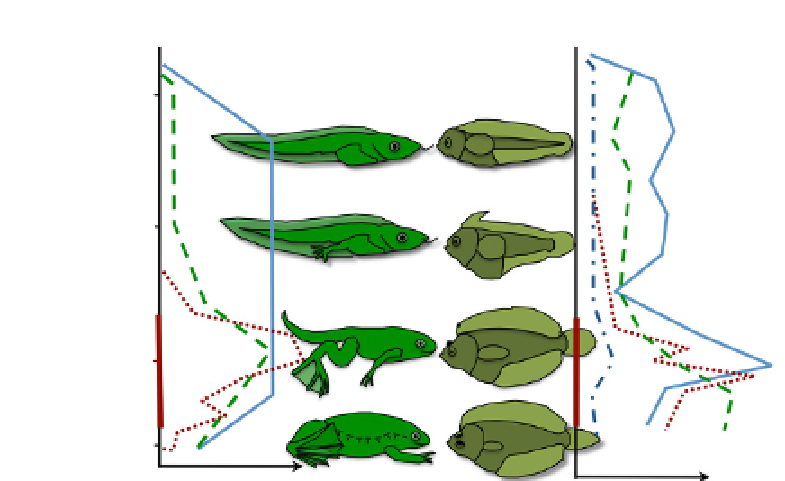Biology Reference
In-Depth Information
Premetamorphic
Larva
TR
a
TR
a
-A
TR
b
TR
b
Prometamorphic
Larva
Metamorphic
climax
TH
TH
TR
a
-B
Postmetamorphic
juvenile
Figure 6.3 A comparison of developmental profiles for thyroid hormone and its recep-
tors in the Japanese flounder (Paralichthys olivaceus) and in the African clawed frog
(Xenopus laevis). Thyroid hormone (TH, dotted lines), thyroid hormone receptor
a
(TR
a
/TR
a
-A, solid lines), TR
a
-B (alternating dash-dot lines), and TR
b
(dashed lines). Data
are derived from
Shi (2000)
(Xenopus) and
Yamano and Miwa (1998)
(flounder).
variables may influence the relative distribution and selection of dextral and
sinistral forms (
Bergstrom, 2007; Bergstrom & Palmer, 2007; Russo et al.,
2012
). Interestingly, not all aspects of morphology and feeding behavior
are found to be exact mirror images of each other with regards to dextral
and sinistral morphs within the genus
Platichthys
(
Bergstrom & Palmer,
2007; Russo et al., 2012
), suggesting that for these species there is an adap-
tive value to lateral polymorphism. The precise selective advantage of sinis-
tral versus dextral morphology, however, still remains unclear. In the case
of flounders within the genus
Paralichthys
, the vast majority of wild-
caught specimens are sinistral. However, when cultured in a laboratory or
aquaculture environment, the incidence of offspring with “reversed” (dex-
tral) asymmetry (see
Fig. 6.2
K and L) has been reported to be much higher
than found in nature for Japanese flounder (
Paralichthys olivaceus
) (see
Okada,
Takagi, Tanaka, & Tagawa, 2003; Okada, Tanaka, & Tagawa, 2003
),
southern flounder (
Paralichthys lethostigma
)(
Benetti et al., 2001; Schreiber,
2006
), Brazilian flounder (
Paralichthys orbignyanus
)(
L´pez et al., 2009
),
and summer flounder (
Paralichthys dentatus
)(
Bisbal & Bengtson, 1993
). Even
in the aforementioned
P. stellatus
populations reported to display virtually
100% sinistrality in Japanese waters, when adults were crossed in an aqua-
culture setting, 13-17% of the offspring were reported to have dextral

